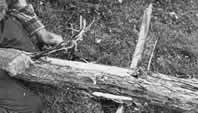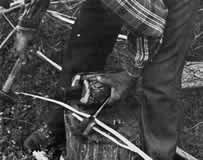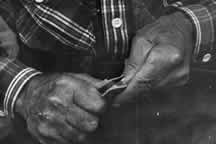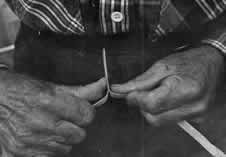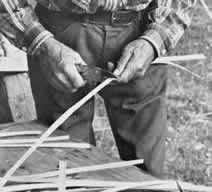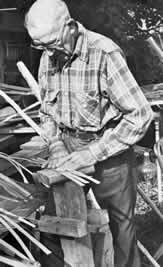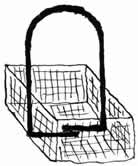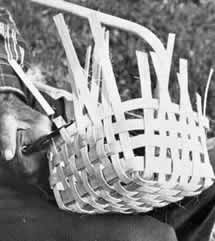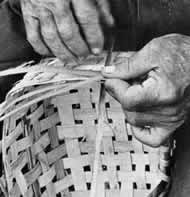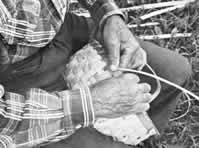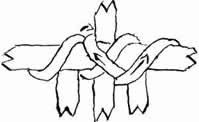BASKETS THE LYN MARBLE WAY
by Doug Sharp and Stephen Ludwig
Photographs by Doug Sharp. Drawings by Jeff Jaynes
From earliest times to the present there has never been anything made that is nicer to hold a Sunday picnic dinner or to use in gathering flowers or garden vegetables than a basket. If the basket is pretty and durable, perhaps the only other requirement to make it better is for it to be homemade from native materials as most baskets were a few generations ago. Then it might have been possible to buy a basket from a local craftsman, but most people probably had to go out in the woods to find the materials to weave one themselves. They made them of grass, reeds, vines, buck-bush runners and any other material their ingenuity could fashion into a basket. Following the methods and using the simple hand tools available to the old-timers, Lyn Marble today makes his baskets of white oak splits.
Lyn Marble is a man who has worked hard in his life and learned many things. He loves to be surrounded by nature, planting every year wildlife patches for "his animals" and caring for his land, especially the acres of many varieties of trees.
He also likes to share his loves and the things he has learned with others. He told us many projects he has worked on such as water witching, splitting rails and hooking rugs. But mostly he told us about baskets. While working on his baskets he always had time to talk and explain what he was doing and why. He never got in a hurry nor got upset when something went wrong. "I learned years ago that when you go to hurrying, you start wasting stuff and things just won't go right for you," he said. He learns from his mistakes and when he makes one, he corrects it so that the next time he will get it right.
The basket makers before the age of power machinery had to have considerable skill to make their strips of uniform width and thickness, perfectly square at the corners and straight along the edges. But they did it and Lyn showed us how.
Ax, or saw to cut down the tree.
Hatchet to start the split for the wedge and act as a temporary wedge.
2 Metal wedges to split the log in halves and fourths.
Small sledge hammer to drive the wedge and drawknife.
Stump or small box to hold up one end of the log when splitting.
Drawknife or fro to split smaller pieces of log and remove the bark.
Pocketknife to start the split on the smaller strips.
- The first step in making the strips for a basket is finding a young straight white oak tree. The best time to cut a tree for strips is in the early spring and late fall because the sap is still in the tree. When the sap has gone out of the tree, the grain is tighter and harder to split.
Cut a log 4 or 5 feet long with a diameter of 4 to 5 inches. This size log makes easier handling. The log should not have any small limbs sticking out from it, for they will cause the strips to have lumps and make it very hard to split straight. The bottom of the log should be cut above the trunk of the tree so that the whole log is straight. If the tree is cut with an ax, it should be trimmed off with a saw later to make the ends straight across so the strips will be all the same length.
- The next series of steps involve splitting the log, first in half, then quarters, eighths, etc., until you get strips thin enough to weave with.
Before splitting the log in half, take off a strip of bark on the upper surface of the log with the drawknife.
If the log is cut in the spring, the bark will come off much easier than in any other time. The bark is loose then and the sap in the wood acts as a lubricant on the drawknife blade.
To remove the bark, straddle the log and bring the drawknife under the bark toward you carefully. This is not too safe, but it has to be done because you can see the grain enabling you to keep the log splitting straight and to keep the depth of the cut more uniform. (see photo #1)
1. use a drawknife to peel the bark away.
2. Always split the log in half.
3. Tap the hatchet in with the sledge hammer to start the wedge.
Now you can start the split. Do this by making a cut with a hatchet in the center of one end of the log. After this, place the wedge in the crack and drive it in with a sledge hammer. (see photo #2) After driving the wedge all the way in, place your hatchet a few inches on down the log at a 45° angle. Drive it in the same as the wedge. This will cause the wedge to fall free as the log splits open. Then move the wedge down the log below the hatchet and drive it in to free the hatchet. Continue this until the log is split open all the way. Remember always to make the split in the exact center of the log.
- Lay one of the halves flat side down on a stump or box. Use the drawknife to remove a strip of bark on the upper surface as before. This is so you can see which way the split is going and correct it if it goes off to one side.
- Slide the half log up onto the stump so that it is balanced. With the hatchet start a crack in the exact center of the log. The hatchet goes in the center of the log. The hatchet goes in the center of the width and also the center of the length. (see photo %3) Start your wedge in the hatchet cut and after driving it clear through the log to the stump, place the other wedge down the log a foot or so and drive it in with the sledge hammer. Pull out the wedge in the center and move it on down the log, thus splitting the whole log. If it doesn't fall apart, cut the strips holding it together with the hatchet. The log should now be split into quarters.
- The next step is to take out the center or heart of the log which is not usable because it Splits and cracks when it dries. Stand one of the quartered logs on end with the point containing the dark center toward you. Place the drawknife cross-ways on the top where the center meets the wood. Tap the drawknife lightly to get it started. You can force it the rest of the way down by just pulling hard. (see photo #4) Usually the split will get out all the center, but if it starts splitting into the heart of the wood use the blade of the drawknife to keep it straight.
4. Don't use the center.
5. Keep your thumbs as far down toward the split as possible while pulling the two pieces apart.
- Next put one end of the quartered log on the stump so that it is supported. Again straddle the log, just as you did in step 2. Remove ail the rest of the bark left on the log with the drawknife.
- After removing all the bark, stand the quarter up on its end. Split it in half as before but you can use the drawknife this time instead of the hatchet. Place the drawknife in the exact center of the end and start it with the hammer. After starting the drawknife into the wood, don't let go of the handle until the blade is all the way in the wood. This is so the blade will not run off to one side. Continue tapping the drawknife with the hammer down several inches until there is room to get your fingers in to get a grip. Finish splitting the quarter in two with your hands. The log is now split into eighths with back and center removed.
- Keep one of the split sections on its end, but this time instead of placing the drawknife across the grain ~s you did all the other splits, place with the grain. This cuts the piece in two, but this split does not split it pie-shaped as before, across the grain, but cuts with the grain. (see drawing #1)
Drive the drawknife in the end with the hammer. After the split is large enough to put your hands in it, grab hold of each side of the split and pull evenly. (see Photo #5) This will cause the split to go on down the wood. If the split goes to one side, pull the opposite side it is going to and don't pull on the same side. This will cause it to go back to the center. After it is right, pull as before.
The portion of the wood nearest to the bark is the best part for making the handle for the basket. Before you make the strips in the next step, cut off a fairly thick strip next to the bark (about 1/4 inch thick). It should be thicker than the strips for extra strength, but not so thick that it won't bend. The width should be that of the strips.
- The pieces are split small enough now that you can begin the rest of the splits with a pocket knife. Take one of the halves of your last split and hold the edge toward you. With the other hand force the pocket knife into the center of the end until the split is long enough to get your fingers in it. (see photo #6) With your thumbs down and palms facing out slip your fingers into the split. Grasp hold of each side of the split so that your index fingers are inside the split. With your thumbs on the outside of the wood bring the two sides of the split down, keeping the split in the middle. (see photo #7) If the split goes to the left, slide the right thumb down the side a few inches ahead of the other thumb. Pulling the right not the left, continue splitting down until the split is forced back to the center of the stick. If the split is on the other side, do just the opposite of this. If as you are splitting, you see little strips of wood holding the two sides together, trim these off with the pocket knife. This will stop them from ripping the very thin strip.
Continue splitting the sections thinner and thinner until the strips are of the desired thickness. You can tell when they are about right by how easily they bend and how flexible they are.
10. After you have enough strips split down to the desired thinness, you should trim the edges. Take the strip in one hand and place one end under your opposite arm, leaving the major portion of the strip behind you. Trim the edge carefully pulling the pocket knife toward you instead of cutting away, because you can cut truer and straighter this way. (see photo #8) The strips should be about 1 inch wide or trimmed to your personal preference. But always make all the strips the same thickness and width so that the basket will look uniform.
6. "The thinner you get it, the better it works.
7. "Got to keep control. Just like an onery woman, you got to keep control."
8. Straighten up the edges to keep uniform width.
Diagram # 1 - Splitting the log
- Cross section of log. 2. Bark removed to split straight. 3. Halved and more bark removed. 4. Quartered. 5. Remove rest of bark. 6. Remove center. 7. Cut in eighths. 8. Halve with grain.
WEAVING THE BASKET
The way we are about to tell you how to make a basket by hand is one way and one style. The length of the strips can be made longer or shorter, wider or narrower depending on the size and style of the basket wanted. The basket can also be woven many ways to make different patterns on the sides and bottom of the basket. Basket weavers created recognized characteristic styles. This is Lyn Marble's style.
Weaving a basket does not need a lot of fancy or complicated tools. Most of the tools can be found readily at hand.
White oak wood splits to weave the basket out of.
Hammer to push the splits together.
Small wood block to be struck by the hammer to push the strips together.
Pocket knife to trim the handle and cut off small fibers.
Small hand hedge trimmer to cut the wood splits.
After the log has been split, you can make the basket before the moisture in the wood dries out, or you can wait. If you choose to wait the splits will dry out, but no harm will be done. When ready to begin weaving the basket, to soften the splits just soak them overnight in a container long enough that the splits do not bend. If a place big enough to hold the splits is hard to find, just fill up your bathtub with water. It will serve the purpose just fine.
After the splits have been soaked overnight they should be very flexible and bend in any direction without cracking or breaking. If they are this flexible, then they are ready for weaving.
To make the basket 5" x 8" x 5" as pictured, use the following splits.
8 or 9 splits at least 4 ft. long. Cut them in 24" lengths for the bottom. They should be between 1/2" and 3/4" wide. All of the splits for the bottom should be about the same width. They can be cut easily with the hand trimmer. (see photo #9)
5 splits about 4 ft. long, 3/4" to 1" wide for weaving around the sides.
2 splits about 1" wide and 4 ft. long for the rim.
4 splits about 4 ft. long and between 1/8" to 1/4" wide to use for wrapping around the rim. Some of the wider splits can be cut in half to make these narrow strips.
1 strip of wood split close to the bark for the handle. Make it about 2 ft. long and between 1/8" and 1/4" thick and 3/8" wide.
Cut strips to use for the bottom and the uprights on the sides of the basket
For beginners it is easier to use a stand to weave the sides and bottom. The stand can be made with a pole or board about 3 feet high with a 5" x 8" x 2" block nailed to the top. This will help in weaving the bottom and the first two side slats.
To begin the bottom, lay down ten strips 24" in length with a little bit of space between them. (see photo #10) Now weave one of the six remaining strips that were cut 24" in length a little to the right of the middle of the ten. (see photo #11) Weave another one a little to the right of the first one. (see photo #12) Weave the next strip to the left of the original one and with your fingers push them as tightly together as possible without bending or breaking them. Now put the wood block up against the strips and strike it with the hammer to push the strips together tightly. If you strike the wood block too hard the strips will crack. Weave the last 3 strips two on the left and one on the right side.
After each strip is woven in, push it in tightly with your fingers, and then use the hammer and wood block. The bottom is now complete with ten strips lying one way with six woven through the middle of them.
10. Lay 10 strips in a row side by side.
11. Weave a 24" strip through the ten.
12. Weave a second strip to the right of the first.
13. Weave a 4' x 3/4" strip around the sides.
To form the sides, bend down the strips and starting on one of the wide sides about the middle, weave one of the 4 ft. strips 3/4" to 1" wide all of the way around the basket. (see photo #13) The wood block on the stand will help form the shape. If you weave the basket in your lap, pull the sides up to weave around the basket. The bottom and the sides should form 90° angles. This will make the sides straight. The sides can be pulled in tighter or looser, depending on how you want your basket to look. When you reach the starting place, cut off the excess length leaving an overlap of 3 to 5 inches which you weave in.
Weave a second strip all of the way around. (see photo #14) Let some overlap and cut it off. It is a challenge to try to hold the first in place while weaving the second one. If you cannot hold the first one, use a staple or a strong paper clip to help hold it in place. If you are weaving your basket on the stand, tack it to the wooden block. After the first and second strips are woven in, push them in tightly with your fingers. By this time the strips should hold each other in place so that if you are weaving your basket on a stand, you can take it off now. Tap the strips together tighter with the block and hammer.
Weave either 2 or 3 more strips around the side of the basket, depending how deep you want the basket, but you should probably weave at least 4 for sufficient strength add depth. (see photo #15)
When the basket is the depth you want, cut off the uprights with the hand trimmer even with the top slat. After each strip is woven in, be sure it is pushed in tightly, for if not, the top slat will usually pop loose. (see photo #16) The sides are now complete and ready for the handle.
Now take the strip chosen earlier for the handle. With the pocket knife trim the ends down so they are thinner than the rest enabling you to insert the handle into the basket much easier. Insert each end of the handle down through the side slats on the inside to the bottom of the basket. (see photo #17) A screw driver can be used to help hold the side slats out while you force the handle through the slats.
The handle can be woven in from the start of the basket, overlapping the two ends for a bottom slat, becoming an upright slat on each side and bending around to form the handle. This is much harder to do, especially for beginners, but makes a strong basket that will prevent the handle from pulling out when there is something heavy in the basket.
Drawing # 2 Showing handle woven in the bottom and sides of the basket
14. Weave a second strip all the way around your basket.
15. Weave as many strips as you want to make the basket as tall as you want.
16. Cut off the remaining uprights even with the last slat.
17. Insert the handle by pushing it down through the side slat all the way to the bottom.
You are now ready to form the rim, using the two 4 ft. strips an inch wide. Put one around the inside and one around the outside of the basket around the top slat. (see photo #18) Cut off the excess length so only about 3" will overlap. Do not let both strips overlap in the same place for more strength and because it will distract from the looks of your basket.
Now using one of the 1/4" rim strips, lap it through under the rim. To hold it in place at the start, go over the rim and through the same place. Now wrap it over the rim and through the opening by the next upright. (see photo #19)
As you go around the rim and through the openings, pull tight each time to form a strong rim. (see photo #20)
When you come to the handle double back one time to wrap the strip through both ways around the handle forming an X pattern on the outside of the basket. (see drawings #3 and #4) Continue wrapping around the rim until you come back to the start. Finish the rim on the inside by pushing the strip through the first two and pulling it tight. (see drawing #5) Cut off the excess. The basket is finished.
18. Place two strips 1" x 4' around each side of the rim. Wrap one 4' x 1/4" strip through the uprights below the top slat to fasten on the rim.
19. Use another strip to continue.
20. Continue wrapping all the way around until you come to the handle.
Drawing # 3 Wrap rim strip around handle to form an X.
Drawing # 4 Then continue wrapping as before.
Drawing # 5 Finish the rim by pushing the strip through first two loops.
If at any time while making the basket you decide to stop, it is all right. The basket will dry out but no harm will be done. To start again just soak the splits and the basket overnight to get them flexible again.
When the basket has dried out, it is almost indestructible. Lyn illustrated this by standing on a basket he had just finished. When it dries out it will be even harder.
Lyn's smile told it all--the satisfaction of constructing with his hands something useful, beautiful and durable out of material from his own land, and the greater satisfaction of sharing his knowledge with us. "I figure that the skill will live at least another sixty years now you boys have learned it," he said after he inspected the basket we made from our own white oak splits.

